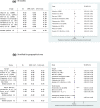Can atopic eczema and psoriasis coexist? A systematic review and meta-analysis
- PMID: 35664974
- PMCID: PMC9060081
- DOI: 10.1002/ski2.29
Can atopic eczema and psoriasis coexist? A systematic review and meta-analysis
Abstract
Importance: Previous studies report both coexistence and mutual exclusivity of atopic eczema (AE) and psoriasis, but these have not been appraised systematically. Knowledge of such disease association throws light on disease mechanisms and may influence therapeutic choices.
Objective: To summarise evidence for AE and psoriasis occurring in the same person at the same point in time. Planned primary outcome was the incidence, prevalence or risk of psoriasis or eczema.
Methods: Ovid MEDLINE and Ovid Embase were searched from inception to 1st February 2020. The search strategy was built around the key terms 'atopic eczema', 'psoriasis' and 'co-existence'. Observational studies (cohort, case-control, cross-sectional and case-series) with a minimum of 10 consecutive patients were included. There were no restrictions on participants, geography or language. Studies were selected, data extracted and critically appraised by two independent reviewers. Data were extracted on the method of diagnosis: health professional (dermatologist, criteria, other), self-reported, not specified. Study quality was assessed using validated Joanna Brigg's Institute critical appraisal tools. A random-effects model was used to combine studies. The effect of study quality on the pooled estimate was investigated using stratification. Heterogeneity was explored by subgroup analysis.
Results: This review included 31 studies and 20 523 individuals with psoriasis and 1 405 911 with AE. Eight studies reported the prevalence of AE in those with psoriasis and values ranged from 0.17% to 20%: the pooled prevalence was 2% (95% confidence interval [CI]: 1, 3). Seven studies reported the prevalence of psoriasis in those with AE and values ranged from 0.3% to 12.6%; the pooled prevalence was 2% (95% CI: 1, 3). Ten studies were assessed as low risk of bias. Geographical area, method of diagnosis, setting and whether the assessment of diagnosis was blinded, partly contributed to the heterogeneity.
Conclusions: This review provides some evidence for the coexistence of AE and psoriasis. Clinicians should be aware of coexistence at diagnosis, when selecting therapies and when reviewing poor response to treatment.
© 2021 The Authors. Skin Health and Disease published by John Wiley & Sons Ltd on behalf of British Association of Dermatologists.
Conflict of interest statement
The authors declare that there are no conflict of interests.
Figures






References
LinkOut - more resources
Full Text Sources
